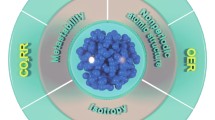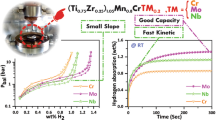Abstract
Ni-based amorphous alloys were synthesized by rapid quenching from the melt, using a planar flow technique. Their amorphous nature and thermal stability were studied by X-ray diffraction and differential scanning calorimetry. The electrocatalytic activity of the as-quenched amorphous alloys with respect to the hydrogen evolution reaction (HER) in alkaline water electrolysis was studied in relation to the alloy composition. The kinetic parameters of the HER were evaluated by cyclic voltammetry and impedance spectroscopy techniques in 6 M KOH at room temperature. The electrocatalytic activity of the amorphous alloys was found to depend on the alloy composition. It was obtained that molybdenum containing amorphous alloys (Ni–Mo–B) showed a superior electrocatalytic activity in the HER compared to Ni–(Nb,Ta)–B and Ni–Si–B, as Ni66.5Mo28.5B5 revealed considerably lower charge transfer resistance and higher exchange current density than Ni63Mo27B10. The results have to be attributed to an improved intrinsic activity of the Ni–Mo–B alloys compared to the other Ni-based glasses.







Similar content being viewed by others
References
Shan Zh, Liu Y, Chen Zh, Warrender G, Tian J (2008) Int J Hydrogen Energy 33:28
Brunelli K, Dabala M, Frattini R, Sandona G, Calliari I (2001) J Alloys Compd 317–318:595
Brookes HC, Carruthers CM, Doyle B (2005) J Appl Electrochem 35:903
Brunelli K, Dabala M, Frattini R, Magrini M (2003) J Appl Electrochem 33:995
Gebert A, Mattern N, Kuhn U, Eckert J, Schultz L (2007) Intermetallics 15:1183
Metikos-Hukovic M, Jukic A (2000) Electrochim Acta 45:4159
Kirk DW, Thorpe SJ, Suzuki H (1997) Int J Hydrogen Energy 22(5):493
Jukic A, Piljac J, Metikos-Hukovic M (2001) J Mol Catal A 166:293
Losiewicz B, Stepien A, Gierlotka D, Budniok A (1999) Thin Solid Films 349:43
Panek J, Serek A, Budniok A, Rowinski E, Lagiewka E (2003) Int J Hydrogen Energy 28:169
Losiewicz B, Budniok A, Rowinski E, Lagiewka E, Lasia A (2004) J Appl Electrochem 34:507
Kubisztal J, Budniok A, Lasia A (2007) Int J Hydrogen Energy 32:1211
Panek J, Budniok A, Lągiewka E (2007) Rev Adv Mater Sci 15:234
Popczyk M (2007) Phys Chem Solid State 8(4):767
Rami A, Lasia A (1992) J Appl Electrochem 22:376
Chen L, Lasia A (1992) J Electrochem Soc 139:3458
Tanaka S, Hirose N, Tanaki T (1999) J Electrochem Soc 146:2477
Chen L, Lasia A (1992) J Electrochem Soc 139:3214
Jaksic JM, Vojnovic MV, Krstajic NV (2000) Electrochim Acta 45:4151
Rosalbino F, Borzone G, Angelini E, Raggio R (2003) Electrochim Acta 48:3939
Spirano S, Baricco M, Antonione C, Angelini E, Rosalbino F, Spinelli P (1994) Electrochim Acta 39:1781
Acknowledgements
The work has been supported by the Bulgarian Scientific Research Fund under grant DO 02-226/2008 and partly by Bulgarian Scientific Research Fund under grant DTK 02-31/2009. The authors thank Dr. Pl. Stefanov (IGIC-BAS) for the XPS analyses.
Author information
Authors and Affiliations
Corresponding author
Rights and permissions
About this article
Cite this article
Mihailov, L., Spassov, T., Kanazirski, I. et al. Electrocatalytic behavior of Ni-based amorphous alloys for hydrogen evolution. J Mater Sci 46, 7068–7073 (2011). https://doi.org/10.1007/s10853-011-5436-5
Received:
Accepted:
Published:
Issue Date:
DOI: https://doi.org/10.1007/s10853-011-5436-5




